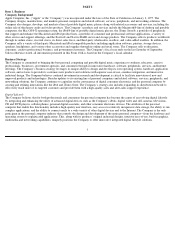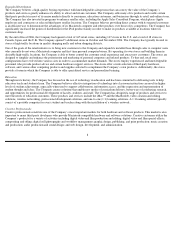Apple 2006 Annual Report Download - page 18
Download and view the complete annual report
Please find page 18 of the 2006 Apple annual report below. You can navigate through the pages in the report by either clicking on the pages listed below, or by using the keyword search tool below to find specific information within the annual report.
Markets and Distribution
The Company’s customers are primarily in the education, creative, consumer, and business markets. The Company distributes its products
through wholesalers, resellers, national and regional retailers and cataloguers. No individual customer accounted for more than 10% of net sales
in 2006, 2005, or 2004. The Company also sells many of its products and resells certain third-party products in most of its major markets
directly to consumers, education customers, and businesses through its own sales force and retail and online stores. Ten percent of the
Company’s net sales in 2006 were through its U.S. education channel, including sales to elementary and secondary schools, higher education
institutions, and individual customers.
Competition
The Company is confronted by aggressive competition in all areas of its business. The markets for consumer electronics, personal computers
and related software and peripheral products are highly competitive. These markets are characterized by rapid technological advances in both
hardware and software that have substantially increased the capabilities and use of personal computers and other digital electronic devices and
have resulted in the frequent introduction of new products with competitive price, feature, and performance characteristics. Over the past
several years, price competition in these markets have been particularly intense. The Company’s competitors who sell personal computers
based on other operating systems have aggressively cut prices and lowered their product margins to gain or maintain market share. The
Company’s results of operations and financial condition can be adversely affected by these and other industry-wide downward pressures on
gross margins. The principal competitive factors include price, relative price/performance, product quality and reliability, design innovation,
availability of software, product features, marketing and distribution capability, service and support, availability of hardware peripherals, and
corporate reputation. Further, as the personal computer industry and its customers place more reliance on the Internet, an increasing number of
Internet devices that are smaller, simpler, and less expensive than traditional personal computers may compete for market share with the
Company’s existing products.
The Company’s music products and services have faced significant competition from other companies promoting their own digital music and
content products and services, including those offering free peer-to-peer music and video services. The Company believes it currently retains a
competitive advantage from innovation and by more effectively integrating the entire solution including the hardware (personal computer and
iPod), software (iTunes), and distribution of content (iTunes Store). However, the Company expects competition in this space to intensify as
competitors attempt to imitate the Company’s approach to tightly integrate these components within their individual offerings or, alternatively,
collaborate with each other to offer solutions that are more integrated than those they currently offer. Some of these current and potential
competitors have substantial resources and may be able to provide such products and services at little or no profit or even at a loss to compete
with the Company’s offerings.
The Company’s future operating results and financial condition are substantially dependent on the Company’s ability to continue to develop
improvements to the Macintosh platform and to the Company’
s hardware, software and services related to digital content to maintain perceived
functional and design advantages over competing platforms.
Raw Materials
Although most components essential to the Company’s business are generally available from multiple sources, certain key components
including microprocessors and application-specific integrated circuits (“ASICs”) are currently obtained by the Company from single or limited
sources. Some key components, while currently available to the Company from multiple sources, are at times subject to industry-wide
availability constraints and pricing pressures. In addition, the Company uses some components uncommon to the rest of the personal computer
and consumer electronics industries, and new products introduced by
17
























